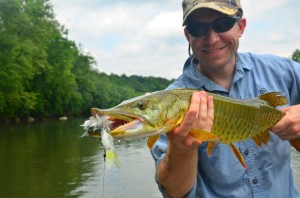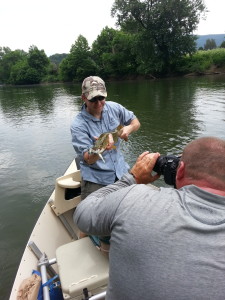Editor’s Note: This article is the first in a series of “How To” guides created and published by Find the Fishing.
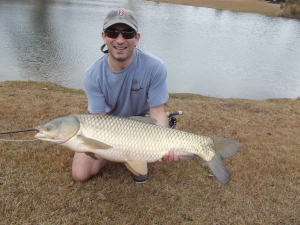
Proof positive that the grass carp can be successfully targeted on the fly rod!
The long standing debate in the fly fishing world: Is a carp a trash fish or game fish? We’ve really seen a trend towards game fish, lately, as we see more people try for the carp, and more people realizing the prize once they hook their first one. Plenty of articles are out there on fishing for carp, and there are even many guides that now specialize in fly fishing for carp. And there isn’t much reason not to – they willingly take a well presented fly (think like a bonefish, not a sunfish), they grow to significant size for a freshwater dweller, and they can even put up a few drag-eating runs. The vast majority of carp people target, though, is the common carp. A much less frequently targeted species on the fly rod is the grass carp, or white amur.
About the Grass Carp
The grass carp is not a native species to the United States. It was imported from eastern Asia as a method to control aquatic weeds. Like the Common Carp, it is also a member of the minnow family, and shares the appearance as well. Just way bigger. They can now be found in 45 states throughout the US, but generally, cannot reproduce naturally in our waters – because few areas have spawning conditions that meet their needs, and most stocked species are sterilized. There have, however, recently been confirmed reports of the Grass Carp reproducing in the Great Lakes Basin. Grass Carp are mainly vegetarian, but will occasionally munch on other animals. These fish can grow BIG (the IGFA World Record is 87 pounds, 10 ounces), and they grow fast. In the ponds I fish, a 5 pound specimen is small, and 10-15 is normal. There are a few bruisers that likely push 20 pounds.
Where to Find Grass Carp
If you’re fishing for Grass Carp in the US, they’re almost certainly stocked. You’ll often find them in man made lakes and ponds, such as community ponds or golf course ponds, to help control the weed population. Make sure you have permission to fish these waters, though, since they’re often private. Some states or localities also stock them in public waters, too.
Once you’ve located a body of water with grass carp, it’s time to find the fish. I’ve found the fish in all parts of the pond – the mud flats, weed/tree lines, the edge of grassy banks, and cruising the depths. When fly fishing, you’re fairly limited to targeting the fish you can see. The fish in each pond tend to develop habits, so you can quickly figure out the best place to find them depending on the time of day. I prefer fishing mud flats and edges of the bank, since the fish tend to be most willing to eat when they’re holding in those areas of the pond, and they’re generally the easiest to see.
Grass Carp Flies and Equipment
Whatever set up you use for Common Carp is fine for Grass Carp. I use a 7 weight Orvis Helios 2 with a Mirage reel, but I’d be just as happy throwing a 6 or 8 weight. A good drag will be very useful. Going lighter than a 6 weight could get you in trouble with some of the bigger fish if you need to apply much muscle to keep it out of thick weeds or obstructions. I typically use a flourocarbon leader, but a floating mono leader will work too. You can go light if you like, but I prefer 0X tippet. 3X broke too often on the hookset.
Despite their primarily vegetarian diet, Grass Crap will eat bugs – both your typical subsurface nymphs and insects that fall into the water. I really prefer fishing on the surface. I generally have a much easier time convincing fish to eat and fly visibility is much less of an issue on long shots or overcast days. Some of my favorite flies:
- Boogle Bug – this fly can catch almost anything. It’s a surface popper that’s killer for most warmwater species like smallmouth bass, largemouth bass, and sunfish. I’ve also caught crappie and perch on it. Bigger versions have seen success in saltwater, and there’s even several accounts of these flies catching trout. Add Grass Carp to the list of species. I’ve had success with their “popper” style in “Solar Flare” (chartreuse), “Electric Damsel” (bright blue), and “Mossy Green.” I prefer smaller sizes for grass carp since despite being bigger fish, their mouths aren’t huge. They have a propensity to “miss” the fly, and I’ve found if a part of the fly touches their mouth before it’s completely eaten, they’ll abort the strike.
- Terrestrials: Beetles, Ants, and Hoppers – Grass Carp have a hard time resisting a well placed bug that “fell” into the water. I haven’t had any luck with a dragon/damselfly on the surface yet, though. Whatever you do, make sure the patterns are tied on an extra strong hook. You aren’t going after 12″ trout. I’ve had several fish straighten the hook on a small beetle. My favorite fly is a beetle pattern from Orvis in size 12.
- Soft Hackles: I prefer fishing these without beads so they stay higher in the water column and can be fished much slower.
- Damselfly Nymphs: These work better in the summer when damsels are actually present. For most species, I like bead chain eyes, but I like lighter weight eyes (like burnt monofilament) again to fish it slower and stay higher in the water column. My go-to damselfly nymph in general is the Rob Snowhite Damsel Nymph.
- “Grass” flies: These are really simple. In community and golf course ponds, people will cut their lawn, and the Grass Carp will feed on the grass clippings. Tie a piece of fake grass (like from a sushi platter) to an extra-strong dry fly hook, and cast it among the feeding carp after the lawns are mowed. This is kind of cheating though.
- Nymphs and bugs: Try a scud pattern, a Hare’s Ear Nymph, or my favorite, the Steelhead Hammer in chartreuse. I use the bright color for ease of visibility. The carp don’t seem to mine. Most other aquatic “bugs” have the potential to draw interest as well.
I’ve personally never had success with bonefish-like flies typically used to target Common Carp, such as a “Headstand” or “Tickler.” Most of those imitate a small crayfish. I’m not sure if the Grass Carp just don’t want to tango with a crayfish or if there aren’t any in the ponds I fish, and therefore look unnatural, but I’ve never even had a second glance. Or, maybe I’ve just never presented those flies well enough…
Presenting the Fly
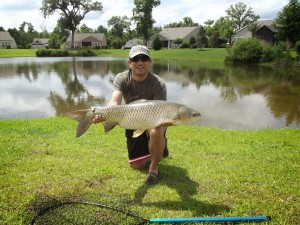 Your presentation starts before you even think about your cast. Grass Carp are probably some of the spookiest fish I’ve ever targeted. You need to creep around like you’re a lion stalking its prey. If I see a fish near the bank, I don’t walk closer than thirty feet. Keep this in mind with every cast you make and every fish you approach. I’ve found fish are more spooky in the winter – or at least what counts as winter in southern South Carolina – than in the spring, summer, and fall, but all still require adequate caution. We’ll break down the presentation into two sections: topwater and subsurface.
Your presentation starts before you even think about your cast. Grass Carp are probably some of the spookiest fish I’ve ever targeted. You need to creep around like you’re a lion stalking its prey. If I see a fish near the bank, I don’t walk closer than thirty feet. Keep this in mind with every cast you make and every fish you approach. I’ve found fish are more spooky in the winter – or at least what counts as winter in southern South Carolina – than in the spring, summer, and fall, but all still require adequate caution. We’ll break down the presentation into two sections: topwater and subsurface.
Topwater Presentations
I limit my topwater fishing to spring through fall. The fish just seem way too spooky in the winter to put up with the splash of a popping bug landing on the surface, and there just isn’t that much terrestrial or surface activity in the winter either. I prefer not to cast to tailing or mudding fish when doing topwater. They’re rarely looking up, so are less likely to see your fly.
The ideal fish to target with topwater is one that is slowly cruising along near the surface. You have a narrow window to present the fly, so accurate casting abilities are crucial. I’ve found the ideal placement is between 2 and 3 feet in front of the fish, but not on the exact line of travel. I believe the placement of the fish’s eyes on the sides of its head makes it more difficult for the fish to see things directly in front of it, and my unscientific studies of hours targeting them seem to support my theory. Drop the fly 6 to 12 inches closer to you than the path of the fish. You can usually do this by using refraction of water to your advantage. Aim to where the fish appears it is, since it will actually be a little further away due to the wonders of physics. I avoid casting to the far side of the fish for a couple reasons – he’s less likely to see the line, and if you miss on your cast, you have less of a chance of spooking the fish. Similarly, I try to avoid casting to a fish swimming away from me.
Sometimes I like a little bit of splash when I drop a popper – you don’t always need to cast it like it’s a size 26 midge. It seems to get their attention, but definitely isn’t a requirement. Good luck with getting a size 16 beetle to make much of a splash. You have to walk the fine line between a small splash and throwing a boulder in the water, though. Once you’ve hit the water, just let the fly sit and don’t twitch it. You’ll know pretty quickly whether the fish is going to take your fly. They seem to make their decision on whether they will eat almost immediately, so you can’t give them any time to consider whether it is really food. You’ll see the fish slowly angle itself upwards and open its mouth to engulf the fly. Nothing is quick about this strike. I’ve never had a fish take topwater after the fly has been in the water for more than 5 seconds, and I’ve never had a strike on a fly that has been moved.
If you miss your cast, it isn’t always the end of the world. Just wait for the fish to swim past before you pick up and try again. The colder the season, the longer you should wait before you pick up. Once the fish is a two or three feet past the fly, it’s usually safe to start stripping it in a few times to make another throw. The only exception to waiting until the fish is past is if you are in danger of “lining” the fish. If the fish feels the leader or line hit its body, it will definitely spook.
Subsurface
Presenting a subsurface fly isn’t significantly different than topwater. You’ll have a little more luck casting at fish that are tailing, since they often are looking for things that got rooted up by their nosing around. You still want to drop the fly about 2-3 feet in front of the fish, but accuracy is less important. If you throw too far ahead, you can wait for the fish to swim closer. Imitate the natural movement of whatever nymph pattern you are using, but slow it down. I have never seen a grass carp chase down a meal. They seem to like to just stumble upon them.
Unlike my topwater presentations, I like casting across the fish when fishing subsurface patterns. Giving the fish the opportunity to see the fly with both eyes seems to help. Bring flies of several weights so you can more easily match the place in the water column where the fish are swimming. I’ve never had one pick something up off the bottom, but that doesn’t meant it won’t happen. I’ve never used an indicator with a nymph since I only sight fish, they might help in lower light or lower visibility situations. The strike is all visual for me, and once again, does not happen fast.
Setting the Hook
Yes, setting the hook requires its own section for no reason other than it took me at least ten strikes before I was able to actually hook a fish. These fish eat S-L-O-W-L-Y. Remember that. Drive it into your head like it is all that matters. Unlike a bass, their food rarely flees, so they don’t need to close their mouths quickly to make sure it doesn’t get away. Remembering that tidbit becomes extremely challenging to remember when you see a fish engulf your fly, particularly on topwater strikes. When you see the take, the key is to count to two or three and slowly and steadily strip in the line. When you feel contact, give it a little bit of a harder tug while being careful not to rip the fly out of the fish’s mouth or popping your leader. Depending on the angle of the fish, you can help make sure it gets into the corner of the mouth by slowly lifting the rod in the direction opposite of the fish’s path. The fish will often hook itself, but not always. If you react as soon as you see the take, you’ll simply pull the hook out of the fish’s mouth.
Once you’ve come tight with the fish, be ready for the battle. Some fish will act like a big roll of paper towels until you try to land it, then it’ll make a drag pulling run. Others will take off immediately and even jump a bit. Make sure you’ve got a good sized net with you, too, because these fish are not easy to land by hand.
Now that you’re ready to get out there, send us pictures of your success!
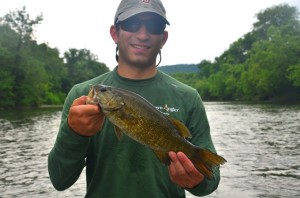 Our day started off pretty slow. There were no musky to be seen. No strikes, no follows, nothing. You shouldn’t expect to see one every cast or every hole, but we were just getting blanked completely. To top it off, we couldn’t even muster a strike or follow from a smallmouths between musky holes. We were starting to get suspicious if fish actually lived in the James at all. Matt changed up my fly to a Tequilly and that woke up the smallies. This section of the James is still recovering from a fish kill and a few poor spawns, so most of the smallmouth were pretty small. That was OK, though, because this river isn’t a place we would have gone to target the smallies. Even still, I ended up with a couple decent size fish that are an absolute blast on the fly rod. Joe wasn’t having quite the same luck and was quick to blame me for stealing all the good holes from the front of the drift boat.
Our day started off pretty slow. There were no musky to be seen. No strikes, no follows, nothing. You shouldn’t expect to see one every cast or every hole, but we were just getting blanked completely. To top it off, we couldn’t even muster a strike or follow from a smallmouths between musky holes. We were starting to get suspicious if fish actually lived in the James at all. Matt changed up my fly to a Tequilly and that woke up the smallies. This section of the James is still recovering from a fish kill and a few poor spawns, so most of the smallmouth were pretty small. That was OK, though, because this river isn’t a place we would have gone to target the smallies. Even still, I ended up with a couple decent size fish that are an absolute blast on the fly rod. Joe wasn’t having quite the same luck and was quick to blame me for stealing all the good holes from the front of the drift boat.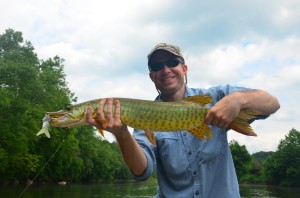 The musky tried its best to escape, but was no match for the 11 wt Helios 2. Joe subdued the fish and Matt scooped it up. It was officially the first Musky either of us had ever caught, and the first one I had even seen in person. At about 33 inches, it wasn’t the biggest fish in the river, but was no baby either. Matt whipped out his camera and snapped a few pictures. As you can tell from the photos, Matt definitely has some photography skills as well as fishing skills. Matt got the fish back in the water and release him to fight another day.
The musky tried its best to escape, but was no match for the 11 wt Helios 2. Joe subdued the fish and Matt scooped it up. It was officially the first Musky either of us had ever caught, and the first one I had even seen in person. At about 33 inches, it wasn’t the biggest fish in the river, but was no baby either. Matt whipped out his camera and snapped a few pictures. As you can tell from the photos, Matt definitely has some photography skills as well as fishing skills. Matt got the fish back in the water and release him to fight another day.